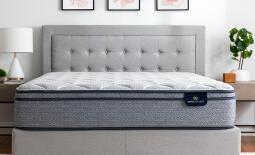Mattress 101 is a regular series that covers the ins and outs of mattresses and their components. From memory foam and innerspring mattresses to hybrids and more—we’re covering what they’re made of, how they’re used and how they can help you get better sleep.
In a world that seems like it’s all about memory foam, we’re here to prove that innerspring beds are still a tried-and-true choice. But to really understand the innerspring mattress, we have to get to know it first. So, get your mental notebook ready, because we’re breaking it down.
The Definition of a Coil
Our definition of a basic coil is a “helical metal spring that can be pressed or pulled.” In layman’s terms: it’s a coiled spring. Innerspring mattresses consist of a number of these coiled springs.
The History of Coils
Fun fact: before coils were invented, mattresses were stuffed with hay and other natural materials. Ouch! The first spring mattress was invented by Heinrich Westphal of Germany in the late 1800s and quickly replaced its outdated, hay-stuffed counterpart. Today, innerspring mattresses are extremely technologically advanced and, due to their ability to provide reliable support, comfort, and long-lasting durability, remain one of the most popular bed types.
Helpful Terminology
We’re confident that you’ll be an innerspring expert by the end of this article, but before we get into the nitty-gritty, let’s cover a few common technical terms. Remember, you can always come back and refer to these definitions if you need to.
- Coil count is the number of physical coils inside the mattress. (You’ll see this referred to in many a product description.) As coil count changes, depending on the type of coil, so do the characteristics of your mattress—the level of support, motion isolation, and more.
- Coil gauge is the thickness of the coil wire. Generally, the higher the coil gauge number, the thicker the wire and the firmer the mattress. (We’ll revisit this later.)
- Multi-zoned refers to when different sections of the mattress offer different levels of support, whether through higher coil count or thicker coil gauge. This is especially useful in providing targeted support for certain areas of the body.
Different Types of Coiled Springs
When it comes to coil systems, the possibilities are endless—but don’t worry, you don’t need to know every single one. We’ve narrowed it down to the most popular coil types used in innerspring mattresses today.
- Wired coils. This interlocked coil system consists of several wired coils that are connected to one another. These coils are probably what comes to mind when you first think of the inside of a “traditional” innerspring bed. Overall, wired coil systems have a smaller coil count (Pop quiz! Remember coil count?) than other types of coil systems, but there’s a reason for that—the interlocking feature makes it great for sleepers who want a consistent feel and consistent support on the entirety of the sleep surface.
- Wrapped coils. Wrapped coil systems consist of several coils that are individually enveloped in fabric. These systems usually feature a higher coil count than wired coil systems and are great for sleepers who want a flexible surface that precisely adapts to the contours of the body. Wrapped coils are also great for isolating motion. (We’ll get to motion isolation a little later.)
- Micro-coils. At first glance, a micro-coil seems like a smaller version of the wrapped coil (micro-coil systems also consist of several coils individually wrapped in fabric), but micro-coils are designed with one objective in mind: comfort. However, this doesn’t mean they lack support (quite the opposite). Micro-coil layers are usually placed close to the surface of a mattress to provide super-adaptable, über-conforming comfort.
The Benefits of an Innerspring Bed
Who wants to do all this learning for nothing? There are countless ways an innerspring mattress can improve your sleep—providing body and spinal alignment, a durable sleep surface, and enhanced support are just a few.
- Adaptability. Innerspring coils are made to adapt to your body (e.g., micro-coils). We’ve covered the most-used coil types, but overall, coils provide a flexible surface that is highly adaptable to any sleeper’s body, regardless of sleep position or body type.
- Motion isolation. Motion isolation helps ensure that one sleeper isn’t disturbed by the movement of another. So, whether that’s tossing and turning or entering or exiting the mattress, your motion is isolated to your immediate area of the bed. In more relatable terms, motion isolation = no more waking up your partner while getting out of bed for your midnight snack.
- Breathability. The nature of innerspring coil systems, with even the most tightly packed coils still having a generally open design, allows for heightened breathability. The spaces between the springs help encourage airflow, which is great for hot sleepers. Sweaty wake-ups, no more!
- Support and durability. Ever heard of someone complaining about sinking too far into their innerspring mattress? We doubt it. Springs exert constant tension to combat exactly that—and their ability to bounce back to their original shape is what makes innerspring mattresses so durable and long lasting.
Now that you know all about innersprings, it’s time to get comfy. Whether you’re searching for your dream mattress or just want to learn a thing or two about beds, you may want to test a few beds out in person to see the difference. And if all else fails, you can’t go wrong with today’s innerspring mattresses. There’s a reason they’ve outlasted the trends.
Find a store near you and one of our Sleep Experts™ will match you with your dream bed in no time. Or try our online Mattress Matcher quiz to find your perfect mattress match.









